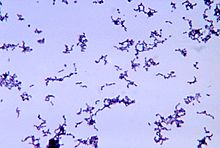- Propionibacterium acnes
-
Propionibacterium acnes 
Scientific classification Kingdom: Bacteria Phylum: Actinobacteria Order: Actinomycetales Family: Propionibacteriaceae Genus: Propionibacterium Species: P. acnes Binomial name Propionibacterium acnes
(Gilchrist 1900)
Douglas & Gunter 1946Propionibacterium acnes is a relatively slow growing, typically aerotolerant anaerobic gram positive bacterium (rod) that is linked to the skin condition acne; it can also cause chronic blepharitis and endophthalmitis, the latter particularly following intraocular surgery. The genome of the bacterium has been sequenced and a study has shown several genes that can generate enzymes for degrading skin and proteins that may be immunogenic (activate the immune system).
This bacteria is largely commensal and part of the skin flora present on most healthy adult human skin. It is usually just barely detectable on the skin of healthy pre-adolescents. It lives primarily on, amongst other things, fatty acids in the sebaceous glands on sebum secreted by follicles. It may also be found throughout the gastrointestinal tract in humans and many other animals. It is named after its ability to generate propionic acid.
Contents
Role in disease
When a pore is blocked, this anaerobic bacterium overgrows and secretes chemicals that break down the wall of the pore and forming an acne lesion (folliculitis), possibly spilling bacteria such as Staphylococcus aureus into the broken skin. Preliminary research shows healthy pores are only colonized by P. acnes while unhealthy ones universally include the non-pore-resident Staphylococcus epidermidis, amongst other bacterial contaminants. Whether this is a root causality, just opportunistic & a side-effect, or a more complex pathological duality between P. acnes and this particular Staph is not known.[1] P. acnes has also been found in corneal ulcers and is a common cause of chronic endophthalmitis following cataract surgery. Rarely, it infects heart valves leading to endocarditis, and infections of joints (septic arthritis) have been reported. Furthermore, Propionibacterium have been found in ventriculostomy insertion sites, and areas subcutaneous to suture sites in patients that have undergone craniotomy. Propionibacterium acnes can be found in bronchoalveolar lavage of approximately 70% patients with sarcoidosis and is associated with disease activity, however it can be also found in 23% of controls.[2][3] The sub-species of P. acnes that cause these infections of otherwise sterile tissues (prior to medical procedures), however, are the same sub-species that are found on the skin of individuals that do not have acne-prone skin and thus are likely local contaminants. Moderate to severe Acne vulgaris appears to be more often associated with virulent sub-strains.[4]
Antibiotic sensitivity
P. acnes can be killed by benzoyl peroxide, tetracycline group and other antibiotics, and many antibacterial preparations, including clove oil,[5] PCMX, and chlorhexidine gluconate. Tetracycline-resistant P. acnes is now quite common. Clindamycin is also frequently used. New facts show that P. acnes is sensitive to some macrolides such as azithromycin, which has a wide spectrum of action. It is normally prescribed 500 mg by mouth, three times weekly for 4 to 6 weeks, but may have post-antibiotic effects by remaining concentrated in lung tissue for approximately 5 days after treatment stops. Fluoroquinolones may also be effective against P. acnes such as nadifloxacin, ciprofloxacin, ofloxacin and levofloxacin.[citation needed] They are active against P. acnes and some other microorganisms that are also part of the poly-infection.[citation needed]
Phage sensitivity
P. acnes has known phages that can attack it, and these can be used to type it. Proposals exist to employ lytic phages for therapeutic purposes for acne vulgaris.
Photosensitivity
P. acnes glows orange when exposed to Wood's light[6]— believed to be due to the presence of endogenous porphyrins. The bacterium is killed by ultraviolet light. P. acnes is also especially sensitive to light in the 405–420 nm (near the ultraviolet) range due to an endogenic porphyrin–coporphyrin III. A total irradiance of 320 J/cm² is found to inactivate this bacteria in vitro.[7] This fact is used in phototherapy. Its photosensitivity can be enhanced by pretreatment with aminolevulinic acid which boosts production of this chemical, although this causes significant side-effects in humans, and in practice was not significantly better than the light treatment alone.
References
- New Scientist news
- Propionibacterium (Kenyon College)
Footnotes
- ^ url=http://www.ncbi.nlm.nih.gov/pmc/articles/PMC2566126/
- ^ Hiramatsu J, Kataoka M, Nakata Y (October 2003). "Propionibacterium acnes DNA detected in bronchoalveolar lavage cells from patients with sarcoidosis". Sarcoidosis Vasc Diffuse Lung Dis 20 (3): 197–203. PMID 14620162.
- ^ Inoue Y, Suga M (2008). "[Granulomatous diseases and pathogenic microorganism]" (in Japanese). Kekkaku 83 (2): 115–30. PMID 18326339.
- ^ url=http://www.ncbi.nlm.nih.gov/pmc/articles/PMC2924382/
- ^ Fu, YJ; Chen, LY; Zu, YG et al., The Antibacterial Activity of Clove Essential Oil Against Propionibacterium acnes and its Mechanism of Action Arch Dermatol 2009 Jan; 145(1):86-88
- ^ Eikone.com
- ^ Papageorgiou P, Katsambas A, Chu A (May 2000). "Phototherapy with blue (415 nm) and red (660 nm) light in the treatment of acne vulgaris". Br. J. Dermatol. 142 (5): 973–8. doi:10.1046/j.1365-2133.2000.03481.x. PMID 10809858.
External links
Actinobacteria (high-G+C) Infectious diseases · Bacterial diseases: G+ (primarily A00–A79, 001–041, 080–109) Actinomycineae Actinomyces israelii (Actinomycosis, Cutaneous actinomycosis) · Tropheryma whipplei (Whipple's disease) · Arcanobacterium haemolyticum (Arcanobacterium haemolyticum infection)Propionibacterium acnesCorynebacterineae Tuberculosis: Ghon focus/Ghon's complex · Pott disease · brain (Meningitis, Rich focus) · Tuberculous lymphadenitis (Tuberculous cervical lymphadenitis) · cutaneous (Scrofuloderma, Erythema induratum, Lupus vulgaris, Prosector's wart, Tuberculosis cutis orificialis, Tuberculous cellulitis, Tuberculous gumma) · Lichen scrofulosorum · Tuberculid (Papulonecrotic tuberculid) · Primary inoculation tuberculosis · Miliary · Tuberculous pericarditis · Urogenital tuberculosis · Multi-drug-resistant tuberculosis · Extensively drug-resistant tuberculosisLeprosy: Tuberculoid leprosy · Borderline tuberculoid leprosy · Borderline leprosy · Borderline lepromatous leprosy · Lepromatous leprosy · Histoid leprosyR3: M. avium complex/Mycobacterium avium/Mycobacterium intracellulare/MAP (MAI infection) · M. ulcerans (Buruli ulcer) · M. haemophilumCorynebacterium diphtheriae (Diphtheria) · Corynebacterium minutissimum (Erythrasma) · Corynebacterium jeikeium (Group JK corynebacterium sepsis)Bifidobacteriaceae Gardnerella vaginalis
Wikimedia Foundation. 2010.
